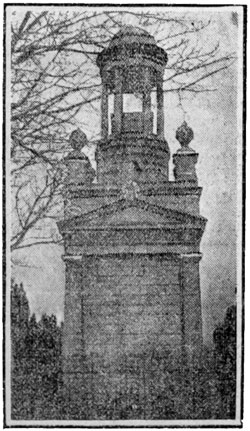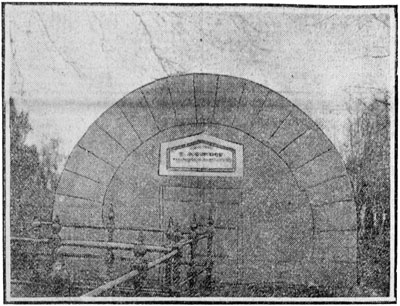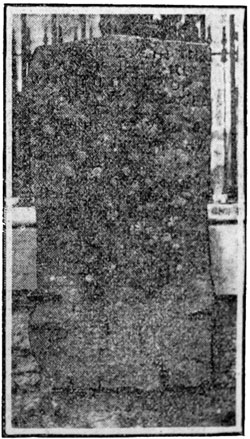Belfast Evening Telegraph, Tuesday, February 12, 1907
XI -- Dundonald Burying-Ground.
Those who are compelled to use the road to Newtownards occasionally may have had their curiosity aroused by an Oriental-looking arrangement set on the top of the hill which forms a background for the sleepy little village of Dundonald. So imposing is the structure as it stands silhouetted against the sky that it is apt to overshadow the little old-fashioned church almost hidden among the clump of trees which adorns the summit of the hill. Quite close to the monument there is a huge mound, and I can remember in the early days being told with mysterious whisperings that this was a giant's grave. They could not (according to the legend) dig the grave deep enough to enclose the great body, so the part which remained out of the ground was simply covered with earth. In reality, this is the rath or dun from which the village adjoining is said to take its name - the fort of Donnell or Donald, one of the O'Neills.
We take a sharp turn to the right after passing the long row of white-washed cottages, and pursue a zigzag course among a series of parochial buildings, in which the ancient is blended with the modern. The little graveyard occupies a position on the face and summit of a slight hill, with the church in the centre at the top. Attention is naturally directed towards the monument which is so prominent from the highway, and when we arrive beside it the height and solidity of the structure is surprising. Built of blue granite, its columns and canopy seem to soar up into the clouds. On one side it bears the following inscription:-
This
Mausoleum
was erected by
Eliza Cleland
In memory of her husband
Samuel Cleland
Of Stormount Esqr.
who died the 25th May, 1842
aged 34 years.
"His earthly remains with those of
His Parents
and several of his progenitors
Are here
Entombed.

The Cleland Mausoleum
In his "History of County Down" Dr. Alex. Knox states that Mr. Cleland was accidentally crushed by a falling wall. The Clelands are one of the oldest families in the district, and the patronage of Dundonald Parish was formerly in one of the line. At the other end of the enclosure there is a peculiarly-shaped vault with the inscription
Family Vault
Of
R. A. Gordon
of Summerfield 1867
The Gordons shared with the Clelands the honour of being the principal families in the vicinity.

The Gordon Vault
Dundonald does not seem to have figured very prominently in the stormy times which have at intervals upset the pastoral peacefulness of the surrounding districts, and yet the scenes of some marvellous prophecies were laid there. One recorded by M'Skimin in "Annals of Ulster" is worthy of record here. "A young maiden with two thumbs on her right hand was to sit upon a large stone and to hold the horses of three kings during the great battle in which Ireland was to be as it were three times lost, but at length won." During this conflict the mill-wheel adjoining was to be turned three times with the blood of the slain, and the maiden was to have crossed the Atlantic Ocean three times, which it was asserted she had already accomplished.
At any rate, from the evidences still obtainable, the people of the district have not in the years gone by been gifted with that fanciful turn of mind which is observable in many old graveyards, and although some of the tombstones are ancient, very few do more than record the particulars of dates of the birth and death of those who lie beneath. There is one prominent exception, and it is a flat stone which lies near the centre of the bury-ground in the upper portion, from which I coped the following:--
"There lies interred beneath this stone
The Commodore who oftimes shone
In cracking jokes with many a guest
And chanting songs in merry taste
Punctual and just in all his dealings
Yet said himself he had his failings
Bad qualities if he had any
Were very few, his good ones many
His heart and hand were always ready
To serve the poor and help the needy,
Had gratitude in high perfection
And died in hopes of Resurrection."
20 May 1776. Aged 48 years.
Why a person considered worthy of such a comprehensive eulogium should have had his name omitted is hard to understand, but the solid fact remains that as far as his tombstone is concerned he must descend to posterity as "The Commodore."
A short distance away to the left of the church there is a heavy flat slab (broken in two pieces) which perpetuates the memory of the McLeroth family, among which is included --
Lieut. Colonel Robert McLeroth
late of the 57th regt. He entered
His Majesty's fervice in 1769, his promotion
-- his merit; alone he ferved in the
American War, was a brave and popular
Officer a Benevolent and kind Brother
Uncle and Friend to all his relatives he died
26th March 1805 in the fixty-fifth year of his
age regretted by all his acquaintances and
Freinds.
The sculptor has again been at fault in this inscription. In the first place it is evident that the semi-colon after "merit" should have been inserted after "alone" -- making it "merit alone," whereas he gives the gallant soldier credit for having served "alone" in the American War. Still a man who could be "a kind brother, uncle, and friend to all his relatives" may have been capable of things we cannot comprehend to-day, but the recorder adds further distinction to the inscription by mis-spelling the word "friends" on its second appearance in the text.

How they preserved the stones at Dundonald
The "Church" is strongly represented not only by past rectors and curates of the parish, but by clergymen of other denominations. There is a very eloquent testimonial to
Rev. James Caldwell,
who was for 47 years pastor of the Presbyterian
congregation of Dundonald.
A man who adorned the Gospel which he taught
by a spotless and exemplary life
Combining all the virtues of a Christian minister
with the warmest philanthropy
the most amiable and engaging gentleness of
manner
And genuine integrity of heart.
An Israelite in whom there was no guile
On the 2nd of October 1811
in the 78 year of his age
he was called to receive the reward
of
A faithful steward.
Not far away there is a flat stone, on which is recorded that
Several of the infant Children
And Grand Children of
John Vance, Merchant, Belfast
are buried here.
While on a marble tablet fashioned like a ship and affixed to this stone we find --
Died
18th June
1883
Revd. Robert Vance, A.M.
Rector for 33years
of Saint Catherine's
Dublin
aged 80years
Son of John Vance
Merchant, Belfast
"Let him alone. Let no man
move his bones." II Kings XXIII 18
The particulars do not indicate whether the deceased was buried here or not, but if not, why the text?
There is another memorial to Revd. Roger Moore Dillon, who was for 41 years rector of the parish and died at 82 years of age in 1851. There are some old stones in a very excellent state of preservation -- 1672, 1693, 1713 -- but only bearing the plain unvarnished details of those who lived and died as ordinary individuals in those far-off times.

